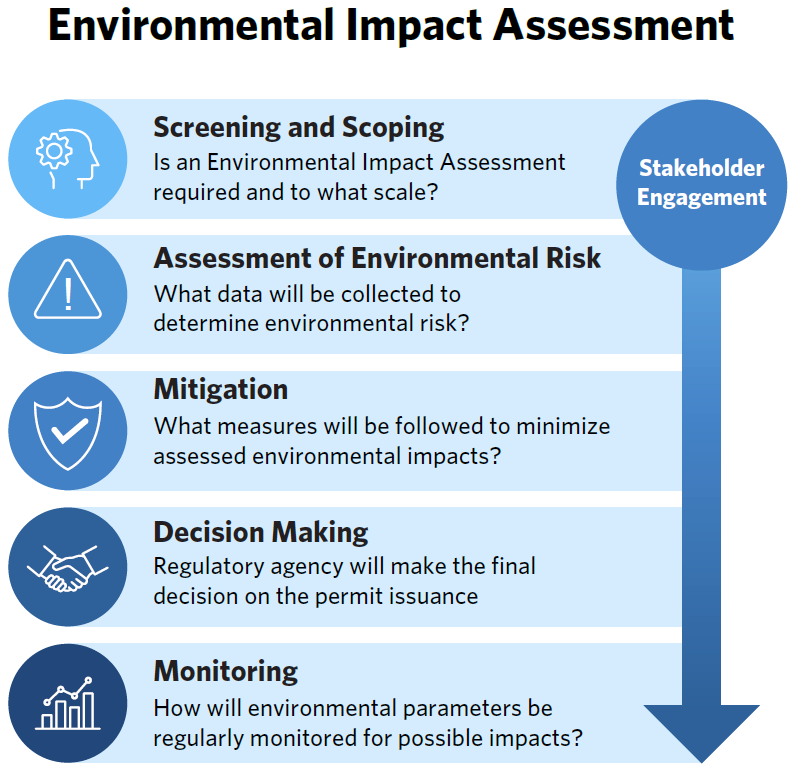Environmental Impact Assessments
Many countries have environmental legislation that requires a review of the potential environmental impacts of a proposed operation before a government permit can be issued (e.g., the United States National Environmental Policy Act). Environmental impact assessments can be defined as “the process of evaluating and mitigating the biophysical, social and other relevant effects of development proposals prior to major decisions being taken or commitments made”. ref Environmental impact assessments are most frequently applied, and are potentially most useful, in cases where a country may not have a well-developed set of aquaculture legislation and regulations that clearly define or constrain which aquaculture operations and practices may be allowed.

Environmental Impact Assessment process. Image © The Nature Conservancy
There are several key steps that are generally undertaken in an environmental impact assessment process:
Screening and scoping: A first step is to determine whether an environmental impact assessment is required and if so, whether a full scale assessment or a more limited review is required. This determination is generally made based on an assessment of the significance of environmental risk and may be triggered by key attributes of the aquaculture project such as size, location, species cultivated, and growing practices proposed by the aquaculture operations. Countries often set thresholds as to the level of environmental review that is required and the information that must be presented within an environmental assessment. Full scale environmental impact assessments are generally required for large scale finfish aquaculture operations that have the potential to significantly impact the marine environment. Less detailed reviews may be required for smaller scale finfish operations, or generally less impactful operations like bivalve or seaweed culture. Countries may also choose to complete “programmatic” environmental impact assessments for specific culture types or sizes, such that general environmental reviews have already been conducted, thereby streamlining review for project applicants of similar farm types or culture species and reducing administrative burdens for governments.
Assessment of environmental risk: The permit applicant or a contractor that is hired by the permit applicant (and often approved to do work by the management agency) will develop an environmental impact assessment. The management agency determines the information that needs to be collected across key impact areas, which are assessed and presented in a report. For finfish operations this may include requirements for a baseline assessment, site survey, effluent and carrying capacity modeling, and risk to habitats, protected species and fish stocks, among other issues. The report typically contains an assessment of proposed alternatives to the project as outlined.
Stakeholder engagement: Public comment is often allowed or required through multiple stages of the environmental review process, during an upfront phase, prior to an environmental impact statement being developed, and once a draft of the environmental assessment document is completed.
Mitigation: An environmental management plan or mitigation measures are usually an output of an environmental impact assessment, though increasingly mitigation may be addressed through standard regulations.
Decision Making: Final decisions on permit issuance are made by the regulatory agency.
Monitoring: Ongoing monitoring of environmental impacts (e.g., wastewater, impacts on wildlife) of an operation may be a contingency of the environmental impact statement.
Countries may develop more specific regulations for the finfish aquaculture sector in addition to, or in lieu of the environmental assessment process. Some of these regulations may include:
- Species selection – use of only native species or naturalized species and prohibitions on culture of invasive or aquatic species
- Modeling to determine carry capacity limits of the area – conducting analysis to determine the number of cages an area can sustain without environmental impacts and setting limits for a determined area or zone
- Discharge limitations, effluent/water quality control and monitoring – considering the volume and quality of the effluent, as well as the incoming and outgoing water quality. Physical/chemical water parameters such as dissolved oxygen, pH, turbidity, and ammonia are monitored and controlled inside determined limits of the production area.
- Benthic effect, sedimentation, and habitat damage – proper site selection, requirement of adequate currents, depth
- Setbacks from habitats or limitations on habitat degradation – siting a safe distance from coral reefs (i.e., 200 m)
- Biomass/stocking densities – maximum stocking densities per cage/farm depending on the characteristics of the site
- Other farm management practices – restrictions in the use of certain types of feed and good feeding management to avoid excess feed and pollution; proper cleaning of cages to avoid disease
- Drug and chemical usage – regulation to determine types of animal drugs and chemicals allowed, quantities, and frequency
- Food safety – harvesting and processing procedures, temperature requirements, worker hygiene requirements
